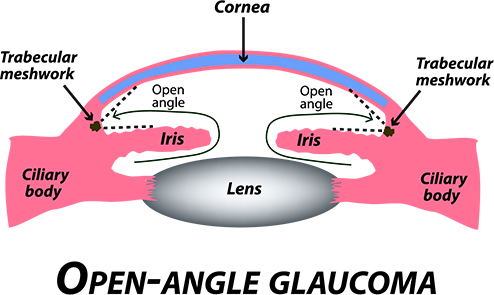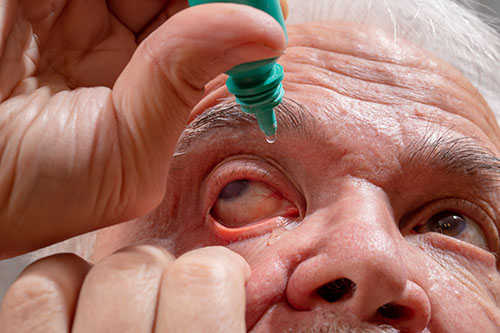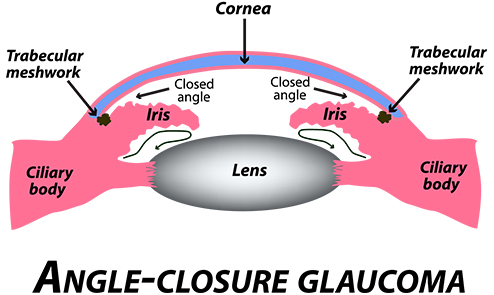What are the types of glaucoma?
Open-Angle Glaucoma

Open-angle glaucoma is the most common kind of glaucoma. It usually affects both eyes, though either eye may be involved earlier or more severely than the other. In this form of glaucoma, there is extra resistance to outflow at the drainage tissue of the eye, the trabecular meshwork. This resistance may be from iris pigment, inflammation, or other debris that blocks the trabecular meshwork. With age, resistance in the trabecular meshwork increases making it more difficult for fluid to get out of the eye, hence glaucoma occurs more commonly in the elderly. Small blood vessel damage of the optic nerve, which contributes to glaucoma, may also play a role. Ongoing research will help determine this role.
Typically, patients have no visual symptoms of glaucoma, so continuous monitoring by your eye doctor is critical. The optic nerve damage from glaucoma usually progresses very slowly and is painless. Initially the peripheral, or side vision, is lost first and goes unnoticed by the patient. Over time, the central vision is involved and then the patient notices, however, by then the disease has progressed to late stages.
Glaucoma damage cannot be reversed, so it is very important to treat glaucoma in its earliest stages. This means that whatever vision is lost, it is lost permanently and is irreversible. The best way to protect against vision loss is to lower eye pressure. Studies have shown that consistently lower eye pressures reduce the risk of glaucoma damage occurring. The most common treatment options are drops and laser to lower the eye pressure. Lowering the eye pressure can halt or decrease the rate of vision loss.
Treatment of open-angle glaucoma
Eye-drops (Topical Medications)

Topical medications (prescription eye-drops) do control glaucoma, but do not “cure” the disease and should be used regularly and faithfully. If you use them inconsistently, then the eye pressure can vary widely, which has been shown in some studies to be as bad as having high eye pressure all the time.
Some of the eye-drops work by reducing the fluid that the eye produces while other drops increase the drainage of fluid out of the eye. The goal of these drops is to lower your eye pressure. By lowering your eye pressure, you can slow or stop glaucoma damage.
There are also oral medications (medications taken by mouth) which are sometimes needed for very high pressure or “acute pressure spikes,” or in patients who do not respond to either drops or laser. Oral medications typically have more side effects and are reserved for the more severe cases.
Sometimes your eye doctor will place you on multiple eye-drops to combine their actions to lower your eye pressure. It is important to use each drop as prescribed. It is also important to wait at least 5 to 10 minutes between drops to avoid washing one drop out with the next.
There are several brands of eye-drops in each class of medicine. A brief review with the name of the most common members of the class is included here. Please see package insert for full details. We refer to them by their brand name with the generic in parentheses. If you experience any side effects, it is important to let your eye doctor know right away.
Prostaglandin Inhibitors
This class of drugs is called prostaglandins, prostamides, or hypertensive lipid group. Some of the common drugs in this class are Xalatan (Latanoprost), Travatan, and Lumigan. They are often used once-a-day at bedtime.
The common side effects are:
- Redness of the eye, which typically is not painful, and is usually temporary.
- Change in iris color from blue-hazel or blue-brown to brown, or darkening of an already light brown iris. These changes are typically permanent but do not represent any precancerous or hazardous change to the eye itself.
- Eyelash growth; this effect is present only when the medication is being used and is not permanent.
Some of the reasons to avoid these medications in the eye include:
- History of herpetic keratitis (herpes virus corneal infection).
- Inflammation in the eye, previous uveitis, and previous macular edema.
While the above are not absolute contraindications, they could recur or be exacerbated by the use of this class of drops.
Alpha-Agonists
The most common drug in this class is Alphagan (Brimonidine).
Some common side effects are:
- Dry mouth.
- Sleepiness or dizziness.
- Redness or conjunctivitis, which can occur when the drop is started and continues as long as the medication is being used. If this side effect occurs, the medication should be discontinued after discussion with your eye doctor.
This class of drug should not be used in children as they can cause sleepiness as well as coma.
Beta-Blockers
This group includes Betimol, Betagan, Istalol (Timolol), and many others. These eye-drops work by decreasing the production of fluid in the eye.
Some common side effects are:
- Slowing of the heart rate.
- Depression.
- Impotence.
These eye-drops are absolutely contraindicated in patients with:
- Asthma, as it may worsen asthmatic symptoms.
- Electrical cardiac disturbances, specifically certain types of heart block.
They are relatively contraindicated in patients with congestive heart failure.
Carbonic Anhydrase Inhibitors
This class of drugs include Azopt and Trusopt (Dorzolamide) as well as the oral preparations of Neptazane and Diamox (Acetazolamide).
Some common side effects include:
- Blurry vision; the medicine is suspended in a thick solution which can temporarily make the vision blurry.
- Stinging upon installation; this medication can burn when dropped in the eyes and the burning can last for a few minutes to a few hours.
- May cause a metallic taste in the mouth and carbonated drinks may taste flat.
- Upset stomach.
- Numbness and tingling of the fingers and toes.
- Aplastic anemia; a shutdown of red blood cell production which is potentially life threatening but a very rare side effect.
There are relative contraindications to using these drops and pills in:
- Patients who have a sulfa allergy, although the reactions are typically minimal, if any.
- If a patient has had kidney stones, this class of drugs may increase the risk of future kidney stone formation.
Acetylcholine Agonists
This class of medication includes Pilocarpine. This medication helps fluid drain from the eye more easily. Pilocarpine is rarely used because of its side effects and its need to be used frequently during the day.
Some common side effects include:
- Vision changes, making vision more blurry and a patient more nearsighted.
- Eyebrow ache or headache, which usually subsides after a week of use.
Combination Eye-drops
Combination drops contain multiple medicines in a single bottle. The goal of these drops is to help reduce the number of physical drops the patient has to place in their eye while maintaining maximum medical control. It also helps improve compliance.
There are several different combinations available:
- Cosopt (contains Dorzolamide and Timolol).
- Combigan (contains Timolol and Alphagan).
- Simbrinza (contains Alphagan and Azopt).
Their side effect profiles are similar to the profiles of their individual components. None of these eye drops are approved for use during pregnancy. Please notify your eye doctor if you are pregnant or might become pregnant.
Closed or Narrow-Angle Glaucoma

Closed or narrow-angle glaucoma may happen suddenly if the eye’s drainage tube (trabecular meshwork) is blocked by the iris. This can cause severe variability and fluctuations in the eye pressure and can also cause optic nerve damage, leading to vision loss. This occurs most often when the iris dilates, as in dark settings (in a movie theater for instance), or can occur after taking certain medications. Some of these medicines include Benadryl, Sudafed, as well as some classes of antidepressants, and should be avoided in patients with this type of glaucoma. If you have untreated narrow angle glaucoma, always check the medication insert for any warnings against usage or talk with your eye doctor if you are concerned.
An acute attack of angle closure glaucoma can cause the eye to be extremely red, severely and suddenly painful with visual halos or rainbows, loss of vision, nausea and vomiting. Emergency treatment is necessary to prevent severe irreversible vision loss from nerve and retinal damage.
Narrow-angle glaucoma is typically first treated with a laser that creates a small hole in the iris. This creates a new path for fluid to flow properly in the eye.
Low-Tension, Normal-Pressure Glaucoma
Low-tension, or normal-pressure glaucoma, is a subtype of open-angle glaucoma that occurs when the optic nerve becomes damaged, even at normal eye pressures. Normal eye pressures range from 10 to 20 mmHg. The reason the optic nerve damage occurs at normal pressure is unknown at this time; however, it is believed to be due to poor blood flow to the optic nerve. This type of glaucoma is treated by lowering the eye pressure as much as possible.
Ocular Hypertension or Glaucoma Suspect
Ocular hypertension or glaucoma suspect is a patient whose eye pressure is elevated but has no evidence of optic nerve damage. Glaucoma suspect patients may differ slightly from ocular hypertension patients in that glaucoma suspect may have a more suspicious-looking optic nerve with normal or mildly elevated eye pressure or have other glaucoma risk factors (such as family history, previous eye trauma, etc.). Treatment is not definitively necessary in either glaucoma suspect or ocular hypertension patients, however, close monitoring is required.
